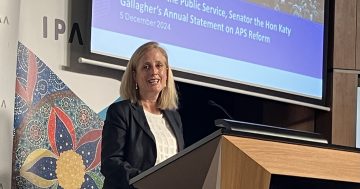
APS Commissioner Gordon de Brouwer says the public service has faced significant challenges over the past year. Photo: APSC.
A total of 555 Australian Public Servants were found to have breached the APS Code of Conduct in the past year, with 61 of them then having their employment terminated.
The State of the Service Report 2023-24 has just been tabled in parliament (26 November), revealing agencies across the service reported that 647 employees were the subject of an investigation into a suspected breach of the code over the year.
Of those, 555 employees were found to have breached the code, with numerous employees being investigated for multiple suspected breaches.
All up, 1369 elements of the APS Code of Conduct were investigated in that period, with 1127 breaches confirmed.
The highest offence was failing to “at all times behave in a way that upholds the APS Values and APS Employment Principles, and the integrity and good reputation of the employee’s Agency and the APS”, for which 472 breaches were confirmed from 535 investigations.
Similarly, 343 investigations into failing to “behave honestly and with integrity in connection with APS employment” confirmed 297 breaches.
A total of 581 sanctions were applied to 356 employees, resulting in 264 reprimands, 167 fines, 70 reductions in salary, 61 terminations, 10 reassignments of duties and nine reductions in classification.
Much of the data for the report is taken from the 2024 APS Employee Census, which found that 10.5 per cent of respondents indicated they had been subjected to harassment or bullying in their workplace in the 12 months preceding the census.
Of those, undermining, interference with work tasks, and verbal abuse ranked as the highest causes of harassment reported.
Overall, reported bullying and harassment levels were similar to the previous year, but reports in some agencies soared while others improved.
“The APS has faced significant challenges, particularly as we responded to the Robodebt Royal Commission, and we have taken system-wide actions to address them,” Australian Public Service Commissioner Gordon de Brouwer states in the report’s opening message.
“We are here to do things, but we are also clear about where the boundaries lie. The policies and services we design and implement must achieve their intended purpose and be ethically sound, as well as legally and technically possible.
“All of the APS Values matter. The vast majority of public servants perform their jobs capably and with integrity.
“Reflecting on our recent lessons learnt in the APS will make us firmer in our resolve to do this.”
The comprehensive report details progress made on a vast array of APS initiatives and reports a high level of employee engagement and satisfaction.
The employee census indicates that APS employees feel positively engaged in their work, with the overall Employee Engagement Index score for 2024 sitting at 74, up from 73 in 2023.
“Employees who are satisfied and inspired by their work, committed to organisational goals and proud of their agency are more engaged in their work and workplaces,” the report states.
“Engaged employees are likely to be more productive and innovative and to deliver outcomes that are aligned with agency objectives.”
The APS workforce spans 583 locations across Australia in 101 agencies.
The Australian Capital Territory is home to 68,435 employees or 36.9 per cent of the workforce.
At 30 June 2024, the APS had 185,343 employees (an 8.9 percentage increase from 30 June 2023) working across 234 job roles.
Full-time employees account for 84.7 per cent of the workforce, part-time employees 11.8 per cent and casual employees 3.6 per cent.
There were 30,540 ongoing engagements and 11,280 ongoing separations over the year.
There are more women employed in the APS than there are men, with women accounting for 60.4 per cent of the workforce and are in the majority across all APS levels and bands except for trainees and graduates.
There is a critical skills shortage across the APS, with 88 per cent of agencies reporting the crisis.
The top five areas of skills shortages for agencies are Digital and information communications technology (81 per cent); Data (80 per cent); Portfolio, program or project management (39 per cent); People management and leadership (37 per cent); and Legal (36 per cent).
“Employing staff in a broader range of locations is one way agencies are addressing critical skill gaps,” the report states.
The Federal Government, however, has highlighted the positives and suggests the report is evidence of Labor’s reform agenda working.
Assistant Minister for the Public Service Patrick Gorman said the report addresses how the APS is serving the Australian people.
“The report highlights the valuable job public servants do each day, with more public servants now working in regional Australia and across the states,” Mr Gorman said.
“Despite a challenging few years, including the impact from Robodebt, it is encouraging to see high engagement levels among APS employees.”
He noted the report highlights substantial progress in strengthening workforce capability, creating an attractive workplace, enhancing workforce representation, and restoring trust with the Australian people.
Original Article published by Chris Johnson on Riotact.








